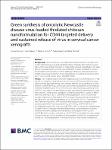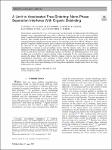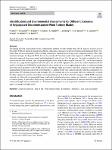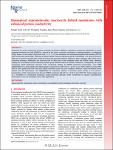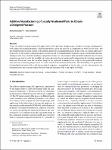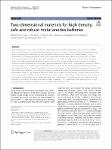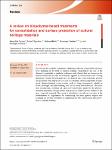Search
Author
- Manyk, T. (3)
- Murawski, K. (3)
- Baumgartner, Jörg (2)
- Guizani, Chamseddine (2)
- next >
Subject
Date issued
- 2023 (187)
Has File(s)
- true (187)
Search Results
Newcastle disease virus (NDV) Lasota strain has proven oncolytic activity. One shortcoming associated with this treatment modality is the immune neutralization of the virus in body, mediated by natural killer cells and macrophages. This study aims at encapsulating the oncolytic virus in thiolated chitosan nanoparticles, surface functionalized with hyaluronic acid for CD44 targeted delivery and sustained release of NDV in cervical cancer tumors. These nanoparticles were tested for oncolytic potential in HeLa cells and cervical cancer xenograft model. |
Nano-phase separating Ni–12 at. pct Ag powders are processed via high-energy ball milling and brought into a supersaturated state with a reduction of the grain size to the nanocrystalline scale, a combination that is designed to encourage rapid densification by phase separation upon heating. This unstable powder is then characterized by dilatometry, in-situ x-ray diffraction, thermogravimetry and microstructure analysis for sintering cycles up to 940 °C. However, these powder compacts exhibit excessive pore evolution and significant macroscopic swelling caused by removal of the organic process additives. This competition of organic removal with densification is known in nanocrystalline metals, but the present study adds an additional dimension of phase separation, which shifts the d... |
The rapidly growing wind industry poses a fundamental problem for wind turbine blade (WTB) disposal in many areas of the world. WTBs are primarily manufactured from composites consisting of a thermoset matrix and reinforcing fibers. Currently, there are no economically viable recycling technologies available for such large-scale composite products. Thus, other treatment strategies for disposed WTBs have to be considered. This study explores the repurpose of WTBs as a promising alternative approach from a processual and technological point of view. For this purpose, the study is guided by the categorization into four different types of repurposed applications: high-loaded complete structure (T1), low-loaded complete structure (T2), high-loaded segmented structure (T3), and low-loaded... |
Enhancing the proton conductivity of proton exchange membranes (PEMs) is essential to expand the applications of proton exchange membrane fuel cells (PEMFCs). Inspired by the proton conduction mechanism of bacteriorhodopsin, cucurbit[n]urils (CB[n], where n is the number of glycoluril units, n = 6, 7, or 8) are introduced into sulfonated poly(ether ether ketone) (SPEEK) matrix to fabricate hybrid PEMs, employing a nature-inspired chemical engineering (NICE) methodology. The carbonyl groups of CB[n] act as proton-conducting sites, while the host–guest interaction between CB[n] and water molecules offers extra proton-conducting pathways. Additionally, the molecular size of CB[n] aids in their dispersion within the SPEEK matrix, effectively bridging the unconnected proton-conducting su... |
Located in Dunhuang, northwest China, the Mogao Grottoes are a cultural treasure of China and the world. However, after more than 2000 years of weathering and destruction, many murals faded and were damaged. This treasure of human art is in danger. Mural inpainting through deep learning can permanently preserve mural information. Therefore, a digital restoration method combining the Deformable Convolution (DCN), ECANet, ResNet and Cycle Generative Adversarial Network (CycleGAN) is proposed. We name it DC-CycleGAN. Compared with other image digital inpainting methods, the proposed DC-CycleGAN based mural image color inpainting method has better inpainting effects and higher model performance. |
Today, the additive manufacturing (AM) approach has led to profound changes in part and process design, enabling previously impossible material properties. With the freedom to create the material as components are built layer by layer, AM has permitted precise spatial control of the material properties in manufactured parts. In this work, an original approach is proposed to locally control component and process design and create intentionally weakened regions with designed fracture, which paves the way to tuneable mechanical properties. Tensile tests of specimens with embedded weakened area of various geometries are used to verify the feasibility of a-priori-designed fracture modes and to characterise the variation in material behaviour. The results show that an ad hoc design of the... |
The magnetic properties of Co/Pt and Co/Pd multilayers of perpendicular synthetic antiferromagnets with an Ir spacer were investigated. A strong interlayer exchange coupling of Jex=2.01
erg/cm2
was observed in the Co/Pt-based structures and a lower value of Jex=1.04
erg/cm2
was found in the Co/Pd multilayers. Only the former revealed a high post-annealing stability at Ta=330∘
C, as the latter exhibited a ferromagnetic coupling most likely due to the deterioration of the spacer by pinhole coupling. This assumption was confirmed by theoretical calculations of the total energy functional. Moreover, the high temperature stability of Ir-based Co/Pt p-SAF structures was verified by calculating the exchange field Hex
from magnetization M(H) loops as a function of temperature, wh... |
With a high specific capacity and low electrochemical potentials, metal anode batteries that use lithium, sodium and zinc metal anodes, have gained great research interest in recent years, as a potential candidate for high-energy-density storage systems. However, the uncontainable dendrite growth during the repeated charging process, deteriorates the battery performance, reduces the battery life and more importantly, raises safety concerns. With their unique properties, two-dimensional (2D) materials, can be used to modify various components in metal batteries, eventually mitigating the dendrite growth, enhancing the cycling stability and rate capability, thus leading to safe and robust metal anodes. In this paper, we review the recent advances of 2D materials and summarize current ... |
Nowadays, the scientific community emphasizes the use of reversible and non-toxic materials in the field of cultural heritage. Biopolymers are one of the alternative materials to synthetic polymers and solvents that are dangerous for human health and for the environment, applied in consolidation and coating treatment. Natural biopolymers may be divided into polysaccharide, protein, and polyester: All of them are low cost, eco-friendly, and biocompatible, besides many physicochemical characteristics such as being transparent, soluble in water, hydrogel, and film-forming, and can be easily functionalized. The addition of nanoclay, essential oil, and active molecules improves the physicochemical properties of biopolymers and proposes smart response abilities to the new composite materi... |
Cellulose has experienced a renaissance as a precursor for carbon fibers (CFs). However, cellulose possesses intrinsic challenges as precursor substrate such as typically low carbon yield. This study examines the interplay of strategies to increase the carbonization yield of (ligno-) cellulosic fibers manufactured via a coagulation process. Using Design of Experiments, this article assesses the individual and combined effects of diammonium hydrogen phosphate (DAP), lignin, and CO2
activation on the carbonization yield and properties of cellulose-based carbon fibers. Synergistic effects are identified using the response surface methodology. This paper evidences that DAP and lignin could affect cellulose pyrolysis positively in terms of carbonization yield. Nevertheless, DAP and lig... |

